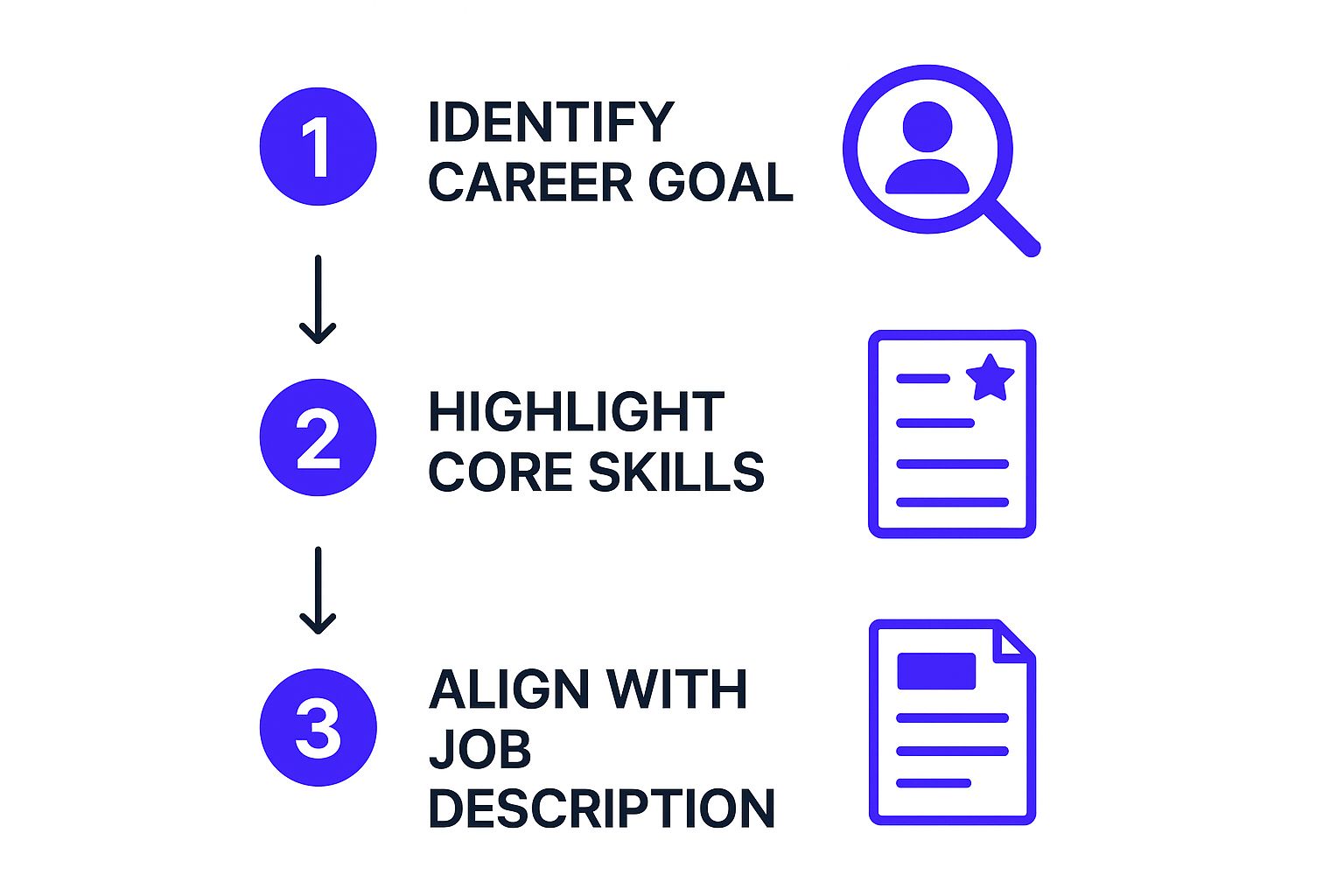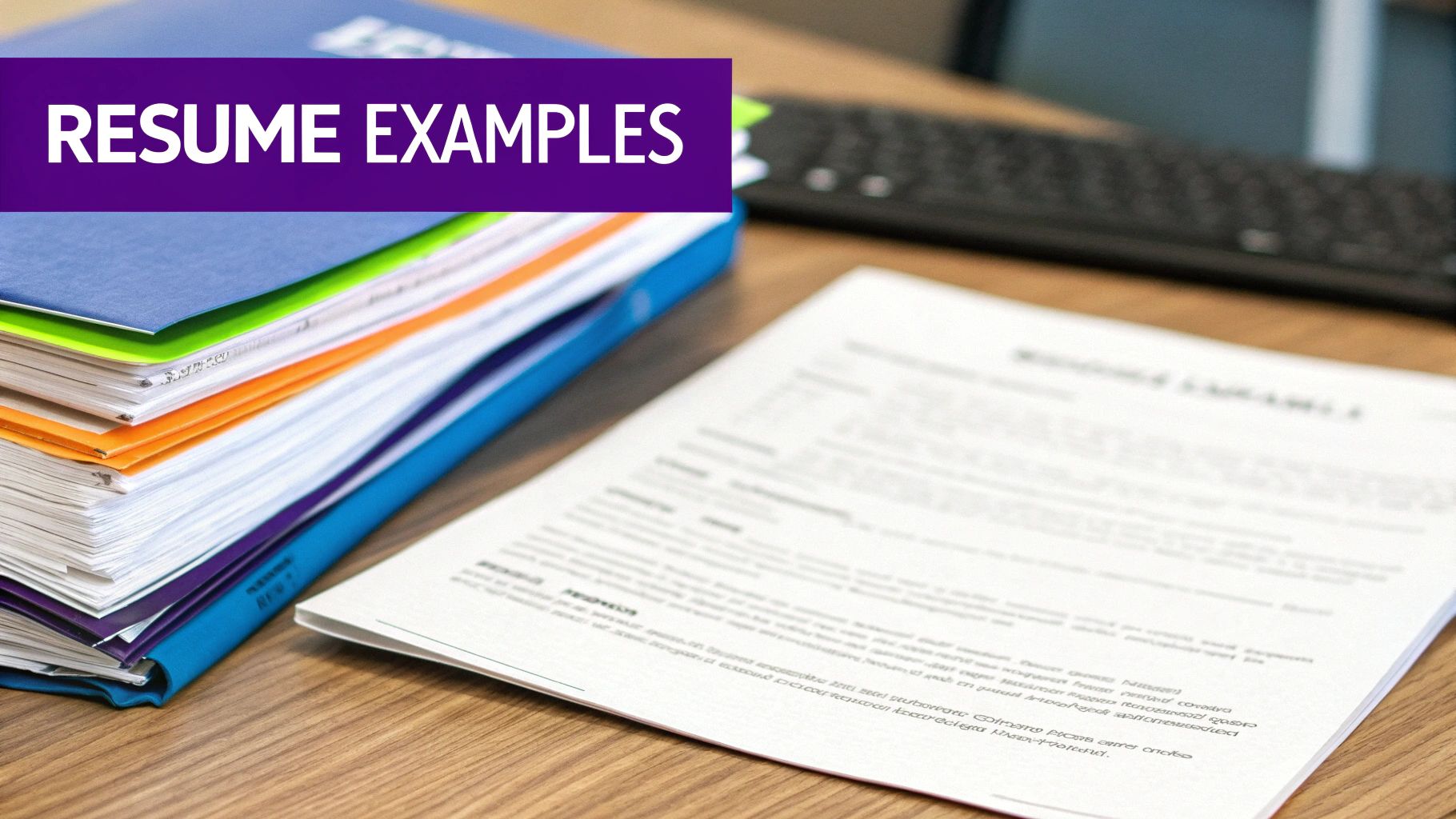How to Write a Resume Objective That Gets Noticed
Let's be real for a moment: the old-school resume objective is dead. Gone are the days of writing "seeking a challenging position where I can utilize my skills." That line is a one-way ticket to the "no" pile.
What's taken its place is something much more powerful: a modern resume objective, which I like to think of as your personal branding statement. It’s your secret weapon for grabbing a recruiter's attention right from the start. This isn't about what you want from a job; it's about showing the immediate, undeniable value you bring to the table.
Why Your Resume Objective Still Matters

Think about it from the hiring manager's perspective. They're staring at a mountain of resumes, and studies show they spend an average of just six seconds on each one. Your opening statement is the most valuable real estate you have. A well-crafted objective frames your entire resume, telling the reader exactly who you are and why you're the right fit before they even glance at your work history.
This short, punchy statement is no longer a fluffy add-on. It's a strategic move that sets the tone, highlights your unique skills, and gives a glimpse into how you'd fit into their company culture.
The Shift to a Personal Brand
The job market has evolved, and your resume needs to keep up. In today's competitive landscape, especially in the US and Europe, a concise personal branding statement is quickly replacing the traditional objective. This isn't just a trend; it reflects a fundamental shift in how we present ourselves professionally. Your identity needs to be consistent, whether it's on your resume, your LinkedIn profile, or in an interview.
This change is happening for a reason. Projections show that a whopping 67% of employers use social media to screen candidates. That means your personal brand has to be on point everywhere. A powerful objective acts as the anchor for that brand, tying your whole professional story together.
Making Every Application Count
Taking the time to master this short statement is what will make you stand out from the crowd. It’s your chance to move beyond a dry list of job duties and tell a compelling story about where you've been and, more importantly, where you're going.
Of course, when you start tailoring your resume for every single role (which you absolutely should be doing), keeping track of it all can get chaotic. This is where using a solid job application tracker becomes a lifesaver. It helps you remember which objective you sent to which company, ensuring you always present a targeted message and avoid any embarrassing mix-ups. A little organization goes a long way in keeping your job hunt efficient and stress-free.
How To Write A Resume Objective From Scratch
Staring at a blank document can be a little paralyzing. I get it. But crafting a killer resume objective isn't about finding some magic template online—it's about building a short, powerful statement from just three core ingredients that show off your unique value.
The whole process boils down to looking inward at what you do best, looking outward at what the employer actually needs, and then blending the two together. Let’s walk through exactly how to nail this.
Start With Your Core Strengths
First thing's first: you need to do a quick personal inventory. What are your most valuable professional assets? Forget job titles for a second and think about real skills and measurable wins.
To get the ball rolling, ask yourself these questions:
- What are the top 2-3 skills I bring to the table that my industry values most? (e.g., Python programming, B2B sales, compassionate patient care)
- Can I point to a specific achievement where I made a real, quantifiable impact? (e.g., “cut project costs by 15%” or “grew our social media audience by 2,000 followers”)
- What’s my professional identity in a nutshell? (e.g., “a data-driven marketer,” “a detail-oriented software developer,” or “a compassionate registered nurse”)
Jot these down. This isn't just busywork; it's the raw material you'll use to build an objective that sounds authentic and hits hard. The goal is to ditch the vague fluff and anchor your statement in cold, hard proof of what you can do.
Deconstruct the Job Description
Alright, time to put on your detective hat. The job description is basically a treasure map telling you exactly what the hiring manager is desperate to find. Read it closely, highlighting key phrases and required skills like you're studying for a final exam.
Key Takeaway: Don't just scan for keywords. Try to figure out the problem the company is trying to solve by hiring for this role. Are they bleeding money and need more efficiency? Are sales lagging? Is customer satisfaction in the gutter?
Your objective needs to frame you as the solution to that specific problem. When you directly connect your strengths to their stated needs, it shows you didn't just spam-apply—you actually thought about how you fit.
This is all about connecting the dots between your goals, your skills, and their needs to create a perfectly targeted statement.

Think of it as a simple formula: your career goals plus your best skills, aligned directly with the job requirements.
Weave It All Together
Now for the fun part. You’re going to combine your findings into a tight, two-to-three-sentence statement. Think of it as a tiny, persuasive sales pitch. If you want to get better at this kind of punchy writing, checking out a practical guide to copywriting can give you a solid foundation.
Here’s a simple framework to get you started:
- Sentence 1: Kick things off with your professional identity and a key strength.
- Sentence 2: Back it up with a quantifiable achievement that proves you're not just talk.
- Sentence 3: Tie it all together by connecting your value directly to the company's goals or the specific role.
This is where a good tool can make your life way easier. For example, the Eztrackr resume builder lets you draft and save different versions of your objective. That way, you can quickly tweak it for each application without having to start from scratch every single time.
Writing an Objective That Beats the Bots

Before your resume ever gets a chance to impress a hiring manager, it has to get past the digital gatekeeper: the Applicant Tracking System (ATS). Think of it as the bouncer at the club. These systems are the first line of defense for recruiters, automatically scanning and filtering hundreds of applications to find the best matches.
Your first job, then, isn't just to write a great resume objective—it's to write one that satisfies the algorithm and the human who will eventually read it. This means being strategic about keywords and formatting right from the very first sentence.
Decoding the Job Description for Keywords
So, where do you find these magic keywords? It’s simpler than you think. The company gives you a cheat sheet: the job description. They are literally telling you what they’re looking for.
Go through the job post and pull out the key terms related to:
- Hard Skills: These are the specific tools and tech. Think Salesforce, Adobe Creative Suite, Python, Java, data analysis, or SEO.
- Soft Skills: Look for phrases like "team leadership," "project management," or "client communication."
- Credentials: Do they require a PMP, BSN, or MBA? Note these down.
Once you have your list, your mission is to weave these exact phrases into your objective. Do it naturally. If the description asks for an "experienced project manager with Agile certification," your objective should mirror that language. This targeted approach is your best bet for getting past that initial digital screen.
Pro Tip: Don't just stuff keywords in. That looks robotic. The trick is to embed them into your accomplishments. Instead of just listing "SEO," try something like, "Drove a 40% increase in organic traffic through targeted SEO strategies." See the difference?
Avoiding Common ATS Formatting Traps
Even with the perfect keywords, simple formatting mistakes can get your resume tossed into the digital trash bin. ATS software prefers clean, simple layouts it can easily understand.
Make sure you steer clear of these common pitfalls:
- Fancy Fonts: Stick to the classics. Arial, Calibri, or Times New Roman are your friends. A script font might look nice to you, but it's often gibberish to an ATS.
- Text in Headers/Footers: Some systems are programmed to completely ignore anything in the header or footer. Keep all your vital info, like your contact details and objective, in the main body of the document.
- Complex Graphics or Tables: That cool chart showing your sales growth? It might confuse the software, causing it to skip over crucial information. Keep it simple.
A clean, straightforward design isn't just about looks; it’s about making sure your value is actually seen. To be extra sure, you can run your resume through a dedicated tool. Our guide on using a resume ATS checker walks you through the steps to ensure your resume is fully optimized.
By combining smart keyword placement with clean formatting, you create an objective that sails right past the bots and lands squarely in front of the hiring manager.
Resume Objective Examples for Any Career Path
Knowing the theory behind a resume objective is one thing, but seeing it work in the real world is where it all clicks. The wrong objective—something vague and generic—can make a hiring manager’s eyes glaze over instantly. But a sharp, focused objective can pull them in and make them want to know more.
The secret usually comes down to swapping out fuzzy statements for hard details that show you’ve actually thought about the employer’s needs.
Let's break down a few "before and after" scenarios. You'll see exactly how to transform a weak, self-centered objective into a powerful statement that gets you noticed.
For the Recent Graduate
If you're fresh out of college, you're probably worried about your lack of on-the-job experience. This often leads to objectives that sound more like wishful thinking than a confident pitch. The trick is to stop talking about what you want and start showing what you can do, using your academic work, internships, and key skills as proof.
- Before: "Recent business graduate seeking an entry-level position where I can apply my education and internship experience to develop professional skills in a growth-oriented environment."
This is all about what the candidate hopes to get. It’s a passive ask that doesn’t offer the company anything concrete.
- After: "Driven Business Administration graduate with internship experience at a leading fintech startup. Led a market research project that identified $50,000 in potential cost savings and presented findings directly to the marketing lead. Eager to apply skills in financial analysis and project management to support the team at Acme Corp."
See the difference? This version is packed with specifics. It mentions a real accomplishment ($50,000 in savings), calls out a hard skill (financial analysis), and even names the target company. It’s active, not passive.
For the Career Changer
Making a career switch is tough. Your biggest hurdle is convincing a recruiter that your past experience is relevant to your new direction. Your objective has to build that bridge for them, showing exactly how your skills transfer.
- Before: "Experienced professional seeking to transition from sales into human resources where I can leverage my people skills and passion for helping others develop their careers."
Words like "people skills" and "passion" are fluff. They don't mean anything without proof, and this version asks the hiring manager to connect the dots on their own.
- After: "Accomplished sales leader with 8 years of experience in relationship building and team development, now transitioning to Human Resources. Successfully mentored over 15 junior reps, leading to a 95% team retention rate. Certified in SHRM fundamentals and ready to apply expertise in talent development and employee engagement to foster a positive workplace culture."
Now that’s a bridge. It translates a sales achievement into an HR-friendly metric (95% retention). It also shows commitment to the new field with a relevant certification (SHRM), proving this isn't just a whim—it's a calculated move.
Key Insight: Notice a pattern here? Both rock-solid examples use numbers to add instant credibility. Quantifying your achievements is the single fastest way to demonstrate your value, whether you're a new grad or a seasoned pro.
For the Seasoned Professional
Even veterans can get lazy with their objectives. At a senior level, your objective needs to be a compact, powerful summary of your value. It should scream leadership and highlight your most impressive skills.
- Before: "Seeking a senior marketing manager position where I can utilize my extensive experience to drive team success."
This is way too generic for a senior role. "Extensive experience" is a claim, not evidence. It’s a waste of prime resume real estate.
- After: "Senior Marketing Manager with over 10 years of experience leading B2B SaaS marketing strategies. Grew qualified leads by 300% through a data-driven content and SEO overhaul, directly contributing to $2.5M in new annual recurring revenue. Seeking to apply expertise in marketing automation and team leadership to scale the marketing efforts at Innovatech."
This one is a knockout. It immediately establishes authority, delivers a jaw-dropping metric (300% lead growth, $2.5M ARR), and links high-value skills directly to the needs of the target company. It’s not just an objective; it’s a promise of what’s to come.
Using Numbers to Prove Your Worth

Let's be honest, numbers just pop off the page. They grab attention in a way that words alone simply can't. When you’re trying to make a strong first impression, quantifying your achievements is what separates a good objective from a great one.
Think about it. A line that includes "30% improves sales" or "15% boosts efficiency" instantly communicates real impact. It’s the kind of language that both modern hiring managers and Applicant Tracking Systems (ATS) are wired to notice.
This approach works because:
- Distinctive metrics prove your value instantly.
- Percentages provide clear, easy-to-grasp comparisons.
- Dollar figures speak a universal language of business impact.
Key Metrics To Highlight
So, where do you find these magic numbers? Start by looking back at your past projects. Dig for anything that can be measured. You’d be surprised—even things like improved customer feedback scores or time saved on a project count as powerful, quantifiable evidence.
If you're in a creative field, think about campaign reach, engagement rates, or how you lowered the cost-per-acquisition.
“Resumes featuring measurable objectives see higher callback rates.”
Remember, most hiring managers only spend about 6 seconds on a resume at first glance. You need to make every word count. As we head toward 2025, the trend is undeniable: clear, data-driven statements are what get you noticed.
Now, imagine swapping out a vague statement like “improved sales” with something concrete: “Increased quarterly revenue by 30% in six months.” See the difference? That level of clarity not only impresses a human reader but also helps the ATS flag your resume for having relevant, high-impact achievements.
How To Find Hidden Metrics
Sometimes the best data is hiding in plain sight. Comb through your old performance reviews, quarterly reports, or sales dashboards. You might find numbers you completely forgot about. Even simple counts, like the number of events you organized or the total clients you onboarded, add significant weight.
The real trick is to pair that hard data with a soft skill to give it some personality. For example, instead of just saying you ran meetings, try: “Coordinated over 50 strategic client meetings, directly enhancing stakeholder satisfaction and project alignment.”
The data backs this up. Statistical analysis consistently shows that resume objectives with precise figures perform better, both with ATS scans and human reviewers. As resume trends for 2025 evolve, highlighting accomplishments like 30% sales growth or a 20% reduction in onboarding time is what will trigger those callbacks. If you want to dive deeper, you can find more research on 2025 resume trends and measurable outcomes.
Integrating Metrics Into Your Objective
Ready to build your own? Start by leading with your professional identity and a killer metric. Then, connect that achievement directly to what the company is looking for in the role.
Here’s a simple framework:
- Start with your title and a metric: "Results-driven Marketing Manager with a track record of delivering 40% lead growth."
- Highlight a specific result: Mention a concrete outcome that lines up with the job description's goals.
- State your value proposition: Finish by explaining how you'll bring that same success to their team.
This is exactly how you write a resume objective that doesn't just get read—it gets remembered. And with a tool like Eztrackr’s resume builder, you can easily experiment with different versions to see which metrics get the best response from employers.
By using precise figures, you're not just making claims; you're providing evidence of your potential from the very first line.
Success Story
I once worked with a project manager who was trying to break into the competitive startup scene. She reworked her objective to lead with a single, powerful metric from a past project: a 15% cost reduction she had spearheaded.
That one number landed her the interview. It became the immediate conversation starter. Instead of generic questions, recruiters jumped right in, asking her how she achieved those savings. Her objective didn't just state her skills; it proved them.
Common Questions About Resume Objectives
Even with the best advice, you're bound to have questions. Crafting a resume objective can sometimes feel like trying to solve a puzzle with unwritten rules. Let's clear up some of the most common questions job seekers ask so you can finalize your resume with total confidence.
Think of this as your last-minute check-in before you hit "send." These answers will lock in the strategies we’ve talked about, making sure your objective is sharp, modern, and ready to impress.
Should I Write an Objective for Every Application?
Yes, you absolutely should. A generic, one-size-fits-all objective is a total relic. The entire point of a modern resume objective is to show a specific company that you are the perfect solution to their unique needs.
Skipping this step is a huge missed opportunity. It immediately tells a hiring manager you’re just blasting out resumes without any real interest in their role. Customizing it for each job is non-negotiable if you want to actually stand out from the crowd.
Key Takeaway: Customization is everything. A tailored objective proves you’ve done your homework and are genuinely invested in the opportunity, which can seriously boost your chances of getting noticed.
How Long Should a Resume Objective Be?
Keep it short and powerful. The sweet spot for a resume objective is two to three sentences, which usually comes out to around 50-80 words. This isn't the place for your life story—it's a high-impact teaser for everything that follows.
Every single word needs to count. If a phrase doesn't add direct value or proof of your skills, get rid of it. Being brief forces you to be clear and impactful.
Is an Objective the Same as a Cover Letter Intro?
Nope, they do different jobs. A resume objective is a super-condensed snapshot of your value, designed to be scanned and understood in just a few seconds. It lives right on your resume and acts as your professional "elevator pitch."
A cover letter introduction, on the other hand, gives you more room to show your personality and tell a bit of a story. It sets the scene for a more detailed explanation of why you're a great fit, often connecting a personal passion or a specific experience to the role.
Once your resume is polished, you might be thinking about other ways to get it in front of the right people. For instance, many professionals wonder about how to add a resume to LinkedIn to maximize their visibility.
Do I Still Need an Objective If I Have Lots of Experience?
Definitely. For seasoned pros, an objective (often called a "professional summary" at this career stage) is arguably even more important. It saves a hiring manager from having to dig through a decade of job titles to figure out what you bring to the table.
Instead of talking about your goals, your summary should highlight your most impressive leadership wins and top-tier skills. It acts as a frame for your extensive experience, telling the reader exactly why you're the strategic leader they need right now. A well-written objective is a crucial part of any strategy for how to get hired faster, no matter what stage of your career you're in.
Ready to stop guessing and start building a resume that actually works? The AI-powered Eztrackr resume builder guides you through creating a perfectly optimized objective and helps you tailor it for every job, ensuring you always make a powerful first impression. Take control of your job search at https://eztrackr.app.
 Interview Sidekick
Interview Sidekick